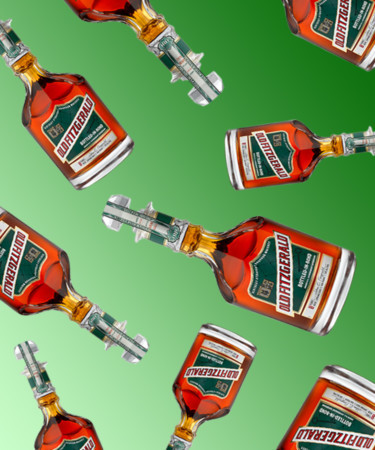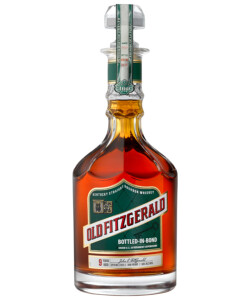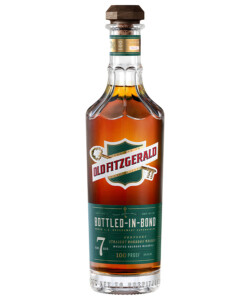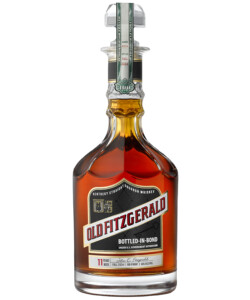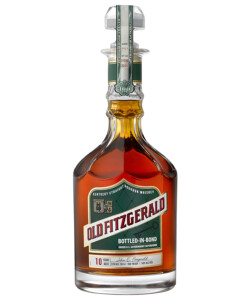Old Fitzgerald is a bourbon favored by novelty-seeking collectors and whiskey historians alike. Its original story is laced with American historical lore, including surviving Prohibition — being one of the few alcohols distilled during Prohibition — and having been produced at the Stitzel-Weller Distillery for more than 50 years. Old Fitzgerald also predates and has historical ties to the Pappy Van Winkle.
Famously known as “Old Fitz,” it was first produced in 1870 at Old Judge Distillery in Frankfort, Ky. Although the Old Judge Distillery closed due to Prohibition, production of Old Fitzgerald continued at Ph. Stitzel Distillery, which would later merge with Weller after the ban had ceased. From its start, it was marketed as a quality bourbon. But it was the “whisper of wheat,” a term coined by Stitzel-Weller, that made Old Fitzgerald a household name.
In the years since its debut, Old Fitz has had a handful of new home distilleries, as its ownership changed several times over, finally landing at Heaven Hill in 1999. Its several brand extensions ultimately made it one of the most highly coveted premium bourbons of all time. Keep reading to learn nine more things about this elusive bourbon.
Old Fitzgerald is a very old bourbon.
Named after distiller John E. Fitzgerald, the whiskey was first produced in 1870 and sold exclusively to private clubs and rail steamship lines. In 1884, Fitzgerald trademarked the name Old Fitzgerald and renamed his popular brand. A few years later during the early 1900s, Old Fitzgerald was released for public sale in America and Europe.
Old Fitzgerald is a wheated bourbon.
After the Stitzel-Weller merger, wheat was introduced to Old Fitzgerald’s original recipe. The change, affectionately known as the “whisper of wheat,” meant that the bourbon mash bill now included a distinct percentage of wheat along with corn and malted barley. This set Old Fitzgerald apart from other bourbons that commonly used rye as a secondary grain, making it a true wheated bourbon.
The Old Fitzgerald recipe was revolutionized by Pappy Van Winkle.
Production of Old Fitzgerald continued at the newly formed Stitzel-Weller Distillery that was formed when the Stitzel Distillery merged with Weller, a Kentucky-based whiskey marketing and distribution firm. It’s here where Julian P. Van Winkle (a.k.a. “Pappy”), originator of adding wheat to bourbon and founder of Pappy Van Winkle, adjusted the recipe, positioning Old Fitzgerald as a premium bourbon with a rounder and softer profile.
Collector bottles of Old Fitzgerald are extremely rare — and pricey.
If the biannual releases are among the distillery’s most sought-after, consider this: Original bottles of Old Fitzgerald are so highly coveted, they sometimes sell for up to $5,000. Old bottles of Old Fitzgerald have become collectors items and are extremely valuable because of their ties to the Stitzel-Weller Distillery. These variations include Very Old Fitzgerald (8 year), Very Xtra Old Fitzgerald (10 year), Very Very Old Fitzgerald (12 year), Very Very Old Fitzgerald (15 year), and Very Very Old Fitzgerald (18 year). With distillations dating back to 1962 and classic original packaging, these bottles are valued at thousands of dollars and are often sold through auction or private markets.
New releases of Old Fitzgerald are highly coveted, too.
Since 2018, Old Fitzgerald has released seasonal limited-edition bottles exactly twice a year, once in the fall and once in the spring. The release of each seasonal bourbon is denoted by the color of the label: A green label denotes a spring release, while a black label indicates a fall release. The maroon label, however, denotes a bottle that is only available in Kentucky.
Old Fitz wears a BiB.
All but one Old Fitzgerald bottling is labeled “bottled-in-bond.” In order to be labeled bottled-in bond, or BiB for short, the whiskey must be American-made and have been aged and bottled in accordance with the legal regulations of the Bottled-in-Bond Act of 1897. Per the BiB Act, the whiskey must be aged for a minimum of four years, have been produced during one distillation season, be bottled at 100 proof or 50 percent alcohol by volume (ABV), and the label must identify the distillery where it was distilled, and where it was bottled, if the locations differ.
Although the brand is most known for its BiB bourbons, there is one version that does not bear the BiB label: Old Fitzgerald Prime. With a lower-alcohol proof of 80 (40 percent ABV), it is significantly cheaper than its BiB-wearing siblings, averaging around $15.99 for a bottle in comparison to, say, $500 for a 9 year BiB bottle of Old Fitz. Old Fitzgerald Prime still uses wheat instead of rye as a flavoring grain, and has soft flavor notes of vanilla, hazelnut, and apple. And while it is the brand’s least premium bourbon, it can — and arguably should — still be sipped and enjoyed neat.
Doctors prescribed Old Fitzgerald as medicine during Prohibition.
During the 13-year ban on alcohol production, sale, and distribution in the United States, Old Fitzgerald was one of the few brands permitted to continue distilling its whiskey for medicinal use. At the time, the U.S. Treasury gave authorization to physicians to write prescriptions advising regular doses of alcohol to their patients. The distillation was government-supervised and prescriptions were to be recorded on government-issued prescription forms.
Diamond decanters are Old Fitz collectors’ best friends.
After it debuted Old Fitzgerald’s new recipe as a premium bourbon that was more refined than its competitors, Stitzel-Weller decided its bottle needed to reflect the same sentiment. So, in 1951, the packaging was redesigned and the bourbon was released in an elegant glass diamond decanter. In the years since, each limited-edition release bears the same packaging to pay homage to the original design.
The wheat may whisper, but the reviews rave.
Thanks to its unique mash bill, Old Fitzgerald is as complex as it is rich and carries through with a smooth finish. VinePair spirits reviewer Tim McKirdy calls out the 14 Year Old Bottled-In-Bond Fall 2020 release’s caramel, vanilla, and butterscotch characteristics; while its 16-Year-Old Bottled in Bond Spring release has softer notes of toasted oak, apple peel, dried apricot, pecan, and walnut. No matter the year or season, the resulting taste of this whiskey’s production is gentle and warming, and ideal for fireside sipping.
